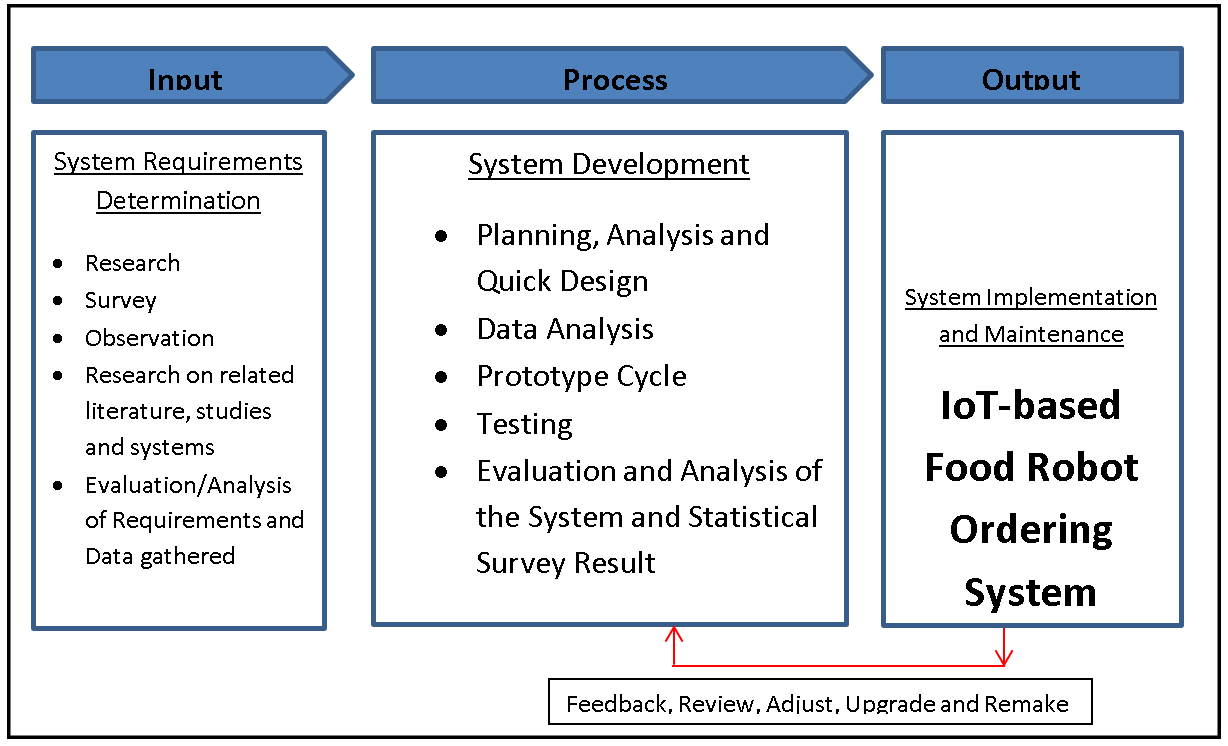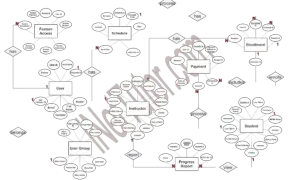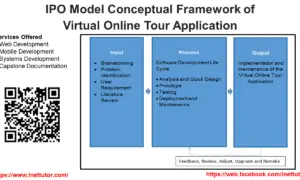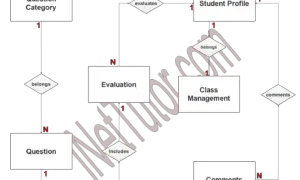Conceptual Framework of IoT-based Food Robot Ordering System
This post will demonstrate how to develop a conceptual framework for a capstone project called Food Robot Ordering System using IOT. The study’s conceptual framework was built using the input, process, and output (IPO) model.
About the Project
Table of Contents
The food sector is continually changing, and technology is playing an important role in improving client experiences. The Internet of Things (IoT) is one such technical progress that has resulted in the development of creative solutions such as IoT-based Food Robot Ordering Systems. These systems use IoT devices and automation to improve productivity, accuracy, and customer happiness by streamlining the meal ordering process.
Food Robot Ordering Systems based on IoT offer seamless integration between many components of the food institution, such as the kitchen, front-of-house operations, and even delivery services. Real-time communication is established by linking IoT devices like as tablets, kitchen display systems, and delivery tracking systems, ensuring easy coordination amongst diverse stakeholders. This integration reduces delays, improves order accuracy, and enables on-time delivery.
Objectives of the Study
The general objective of the research study on the IoT-based Food Robot Ordering System is to design, develop, and implement an advanced technological solution that optimizes the food ordering process within various dining establishments. This system aims to enhance efficiency, accuracy, and customer satisfaction by seamlessly integrating IoT technology and robotic automation into the food service industry.
Specific Objectives
- To significantly enhance the efficiency of food ordering, expediting the process for both customers and establishments.
- To institute a robust automation system that eliminates human errors, drastically reduces order processing time, and optimizes the entire operational workflow.
- To elevate order accuracy to new heights by mitigating the potential for miscommunication or misinterpretation that often occurs in manual order taking.
- To craft a dining experience that’s not only seamless but also personalized, catering to the unique preferences of each customer.
- To establish a dynamic, real-time communication network that seamlessly links various facets of food establishments, including the kitchen, front-of-house operations, and delivery services, fostering unparalleled efficiency and coordination.
What is a Conceptual Framework?
A conceptual framework is a structured model outlining the essential concepts, variables, relationships, and methodologies relevant to a research project or study. In a capstone project, it serves as a foundational blueprint, helping researchers define the project’s scope, objectives, and methodology. Specifically, in the development of an IoT-based Food Robot Ordering System, a conceptual framework is invaluable. It aids in identifying key system components, such as sensors, robotic mechanisms, communication protocols, and user interfaces, and conceptualizing how these elements interact to form a cohesive, functional design. Additionally, it guides the methodology for data collection, processing, and analysis, ensuring the system aligns with user needs and remains efficient.
Overall, a conceptual framework offers a structured approach to the project, ensuring it remains focused and organized. It serves as a roadmap for systematic development, guaranteeing that the IoT-based Food Robot Ordering System meets its objectives and contributes to the advancement of technology in the food service industry, enhancing both customer experiences and operational efficiency.
Conceptual Framework Diagram

The image above depicts the project’s conceptual framework, entitled IoT-based Food Robot Ordering System. It is based on the input, process, and output (IPO) model.
Input
The project will begin by evaluating the present process, which will lead to the stage of doing research, survey and observation. The researchers will also need to compile relevant papers and systems to use as a guide for the project’s development. After all such process, the researchers will evaluate and analyze the requirements and data gathered.
In the input phase of the development of an IoT-based Food Robot Ordering System, these activities serve the following purposes:
Research: Research involves exploring existing technologies, trends, and best practices in the field of IoT, robotics, and food service. It helps in understanding the current state of technology, identifying potential challenges, and gaining insights into innovative solutions that can be incorporated into the system.
Survey: Surveys help in gathering data directly from potential users, such as restaurant owners and customers. Surveys aim to understand user preferences, pain points, and expectations regarding food ordering processes. This information is crucial for tailoring the system to meet user needs effectively.
Observation: Observation involves firsthand assessment of restaurant operations and customer behaviors. By observing how food orders are placed and processed in real-world settings, developers can identify bottlenecks, inefficiencies, and areas where automation through robotics and IoT can improve the process.
Research on Related Literature, Studies, and Systems: This activity involves an extensive review of existing literature, academic papers, and case studies related to IoT-based food ordering systems and robotic applications in the food industry. It helps in building on prior knowledge, identifying best practices, and avoiding pitfalls in system development.
Evaluation/Analysis of Requirements and Data Gathered: Once data is collected through research, surveys, and observations, it needs to be evaluated and analyzed. This analysis helps in defining the specific requirements for the system, such as the types of sensors needed, the communication protocols to be used, and the user interface design. It ensures that system development aligns with the insights gained from these activities and addresses real-world challenges effectively.
Process
The researchers will select and choose the optimum software development life cycle model for the project in this section.
Planning, Analysis and Quick Design
During Analysis and Quick Design, the researchers did a personal interview with the respondents and the chosen client where the study was conducted. The respondents were given the chance to suggest how the system will be designed. After conducting the data gathering, the researchers made an initial design for the proposed system.
Data analysis
Consultation is used to gather requirements from end users and generate ideas. We also distributed a survey questionnaire that was authorized by three experts (IT Expert, English Grammarian, and Researcher). And these questionnaires functioned as our data gathering tool, measuring the performance of the manual system that served as the foundation for the development of our proposed system.
Prototype
The prototype and planned system features are developed at this phase. A concrete understanding of how the system will function is also created. We identify all of the necessary system inputs and outputs, as well as the design of data, processes, and interfaces, in this part.
Testing
In this phase, the researcher performed series of testing to check for any possible problems may arise during implementation and operation of the software and if the specification has been met.
Evaluation and Analysis of the System and Statistical Survey Result
This will include the feed backing of the proposed system after it will be implemented and had undergone testing by three Experts. It will also inform the researchers and the developer if there are any bugs, suggestion and if the system’s functionality will work well.
This will discuss the implementation of the proposed system wherein Three (3) Experts will evaluate the proposed system. This will also discuss if the recommended functions and suggestion are met.

Output
The project comes to life and is executed in the real world after all of the necessary procedures have been completed. A new project is born, and it will be maintained for the project’s long-term survival.
The successful implementation of an IoT-based Food Robot Ordering System can yield a range of positive outcomes, benefiting both food establishments and customers. Here are some possible outcomes:
- Enhanced Efficiency: The system can significantly streamline the food ordering process. Orders are placed electronically and transmitted directly to the kitchen, reducing order processing time and minimizing errors. This leads to faster service and improved efficiency in food preparation and delivery.
- Improved Order Accuracy: Automation reduces the possibility of human errors in order entry and transmission. This, in turn, enhances order accuracy, ensuring that customers receive the correct items, thus reducing customer complaints and returns.
- Personalized Customer Experience: The system can be designed to store customer preferences and order history, allowing for personalized recommendations and promotions. This enhances the overall dining experience and customer loyalty.
- Cost Savings: With automated order processing and reduced errors, food establishments can lower labor costs and minimize food wastage. This contributes to improved profitability and sustainability.
- Real-time Data Insights: The system generates real-time data on customer preferences, order patterns, and peak dining times. This data can be used for data-driven decision-making, menu optimization, and resource allocation.
- Competitive Advantage: Food establishments that adopt this technology gain a competitive edge by offering efficient, accurate, and technologically advanced services. This can attract more customers and strengthen brand reputation.
- Scalability: The system can be scaled to meet the needs of different types and sizes of food establishments, from small cafes to large restaurant chains. This scalability enhances its versatility and market applicability.
- Customer Convenience: Customers benefit from a convenient and user-friendly ordering process. They can place orders from their smartphones, choose delivery or pickup options, and track the status of their orders in real time.
- IoT Ecosystem Integration: The system can serve as a foundation for integrating other IoT devices and applications within food establishments, such as inventory management, temperature monitoring, and security systems.
- Data Security: Ensuring robust data security and privacy measures within the system can build trust among customers, safeguarding their personal and financial information.
Summary
In this blog post on Conceptual Framework of the IoT-based Food Robot Ordering System, we’ve ventured into the future of the food service industry. This conceptual framework serves as the guiding blueprint for a transformative project that combines IoT technology and robotics to revolutionize how we order and enjoy food.
In the summary of our blog post, we’ve journeyed through the Input phase, where thorough research, surveys, observations, and the review of related literature laid the foundation for the project’s design. We’ve seen how these activities contribute to the system’s development, ensuring it aligns with real-world challenges and user needs.
Moving forward, the Output phase promises a range of positive outcomes. With increased efficiency, improved order accuracy, and personalized customer experiences, the system stands to benefit both food establishments and customers alike. Additionally, the scalability and potential for integration with other IoT devices position it as a game-changer in the food service industry.
This Conceptual Framework offers not only a glimpse into the technological advancements reshaping the industry but also a testament to the power of research and innovation in solving real-world challenges. As the project progresses from concept to reality, it holds the promise of elevating dining experiences and setting new standards for efficiency and convenience.
Readers are also interested in:
Abstract of Arduino Based Automated Plant Watering System
You may visit our Facebook page for more information, inquiries, and comments. Please subscribe also to our YouTube Channel to receive free capstone projects resources and computer programming tutorials.
Hire our team to do the project.


